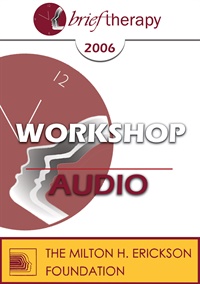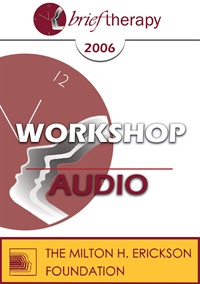- Average Rating:
- Not yet rated
- Topic Areas:
- Clinical Demonstrations | Pain and Healing | Brief Therapy | Hypnosis | Trance
- Categories:
- Brief Therapy Conference | Brief Therapy Conference 2003
- Faculty:
- Stephen Lankton, MSW
- Course Levels:
- Master Degree or Higher in Health-Related Field
- Duration:
- 59:27
- Format:
- Audio and Video
- Original Program Date:
- Dec 12, 2003
- Short Description:
- Educational Objectives: 1) To describe the use of three trance phenomena in the reduction of pain. 2) To describe how hypnosis for pain control can be introduced in brief therapy.
- Price:
-
Sale is $29.00
price reduced from Base Price - $59.00
- Average Rating:
- Not yet rated
- Topic Areas:
- Clinical Demonstrations | Hypnosis | Brief Therapy
- Categories:
- Brief Therapy Conference | Brief Therapy Conference 2006
- Faculty:
- Michael Yapko, PhD
- Course Levels:
- Master Degree or Higher in Health-Related Field
- Duration:
- 1:01:08
- Format:
- Audio and Video
- Original Program Date:
- Dec 08, 2006
- Short Description:
- BT06 Clinical Demonstration 07 - Multi-Dimensional Problem-Solving with Hypnosis - Michael Yapko, PhD
- Price:
-
Sale is $29.00
price reduced from Base Price - $59.00
- Average Rating:
- Not yet rated
- Topic Areas:
- Clinical Demonstrations | Hypnosis | Psychotherapy | Brief Therapy
- Categories:
- Brief Therapy Conference | Brief Therapy Conference 2006
- Faculty:
- Stephen Lankton, MSW
- Course Levels:
- Master Degree or Higher in Health-Related Field
- Duration:
- 54:30
- Format:
- Audio and Video
- Original Program Date:
- Dec 08, 2006
- Short Description:
- BT06 Clinical Demonstration 10 - Introducing Hypnosis into Psychotherapy - Stephen Lankton, MSW, DAHB
- Price:
-
Sale is $29.00
price reduced from Base Price - $59.00

- Average Rating:
- Not yet rated
- Topic Areas:
- Dialogues | Hypnosis | Brief Therapy
- Categories:
- Brief Therapy Conference | Brief Therapy Conference 2006
- Faculty:
- Betty Alice Erickson, MS, LPC, LMFT | Michael Yapko, PhD
- Duration:
- 1:06:50
- Format:
- Audio Only
- Original Program Date:
- Dec 08, 2006
- Short Description:
- BT06 Dialogue 06 - Overstating/Understating the Merits of Hypnosis in Treatment - Betty Alice Erickson, MS & Michael Yapko, PhD
- Price:
- $15.00 - Base Price

- Average Rating:
- Not yet rated
- Topic Areas:
- Short Courses | Brief Therapy | Hypnosis | Therapist Development
- Categories:
- Brief Therapy Conference | Brief Therapy Conference 2006
- Faculty:
- Rubin Battino, MS
- Duration:
- 1:19:30
- Format:
- Audio Only
- Original Program Date:
- Dec 07, 2006
- Short Description:
- The expectation of the therapist that therapy can be both very brief and effective is the essence of working in the very brief mode, i.e., the therapist rarely sees the client more than one or two times. Typical methods used are: the miracle question, changing personal history, guided metaphor, conversational reframing, Rossi's "moving hands," and hypnosis. Case examples will be given, and the group will be invited to participate in a brief hypnotic change experience.
- Price:
- $15.00 - Base Price

- Average Rating:
- Not yet rated
- Topic Areas:
- Short Courses | Brief Therapy | Dreamwork | Hypnosis | Metaphors | Trauma
- Categories:
- Brief Therapy Conference | Brief Therapy Conference 2006
- Faculty:
- Deborah Beckman
- Duration:
- 1:18:59
- Format:
- Audio Only
- Original Program Date:
- Dec 07, 2006
- Short Description:
- Dreaming is a vital, nightly function of the brain. Disturbing dreams or recurrent nightmares are frequent symptoms of an acute focus on unresolved conflicts and events. Clients can learn to reclaim comforting sleep even before the overt reasons for seeking therapy are directly addressed. The potential of individualized metaphors structured within lucid dreaming empowers clients to "seize" the night." Hypnotic techniques offer an intriguing path that bypasses a client's ingrained fear of "falling to sleep."
- Price:
- $15.00 - Base Price

- Average Rating:
- Not yet rated
- Topic Areas:
- Workshops | Cognitive Behavior Therapy (CBT) | Hypnosis | Suggestion
- Categories:
- Brief Therapy Conference | Brief Therapy Conference 2006
- Faculty:
- Michael Yapko, PhD
- Duration:
- 2:39:09
- Format:
- Audio Only
- Original Program Date:
- Dec 10, 2006
- Short Description:
- Hypnosis has been shown to enhance the effects of treatment in general, and CBT in particular, making treatment more effective and with more enduring results. Hypnosis as a field is supported by a body of scientific literature that is broad, deep and fascinating, addressing issues such as information processing, the relationship between the brain and the mind, the dynamics of interpersonal influence, and how suggestions become realities. As practicing clinicians, we have a great deal to learn from studying hypnosis whether we ever intend to become "hypnotists" or not. The role of suggestion - influential communication - is so basic to any healing technique that to ignore, avoid, or underestimate its impact in the therapy process weakens our ability to practice therapy effectively.
- Price:
- $15.00 - Base Price

- Average Rating:
- Not yet rated
- Topic Areas:
- Workshops | Brief Therapy | Hypnosis | Psychotherapy
- Categories:
- Brief Therapy Conference | Brief Therapy Conference 2006
- Faculty:
- Stephen Lankton, MSW
- Duration:
- 2:37:19
- Format:
- Audio Only
- Original Program Date:
- Dec 10, 2006
- Short Description:
- Research shows that treatment paired with hypnosis is more effective than treatment alone for many types of problems. The science and art of hypnosis is now widely recognized as a component tool for psychotherapy and has been employed successfully as a comfortable part of private practice and agency practice for years. As hypnosis spreads into the mainstream of psychotherapy, it is important to get competent information regarding its use. Lacking that, many practitioners do not make use of the advantages it provides as an adjunct to a well-rounded set of clinical skills. This workshop is intended to correct that lack of understanding and training in this important area. The rationale, indications and basic use will be explained and demonstrated with practical exercises to help convey the key language skills that are requisite.
- Price:
- $15.00 - Base Price

- Average Rating:
- Not yet rated
- Topic Areas:
- Workshops | Hypnosis | Experiential Therapy | Brief Therapy | Homework
- Categories:
- Brief Therapy Conference | Brief Therapy Conference 2006
- Faculty:
- Jeffrey Zeig, PhD
- Duration:
- 1:58:24
- Format:
- Audio Only
- Original Program Date:
- Dec 10, 2006
- Short Description:
- An experiential orientation empowers therapeutic change. Dramatic experiential methods can be used by any clinician in every stage of the therapeutic process including assessment, in session treatment and homework assignments. Techniques to be demonstrated and practiced include therapist sculpting, symbolic assignments and analogical tasks.
- Price:
- $15.00 - Base Price

- Average Rating:
- Not yet rated
- Topic Areas:
- Workshops | Hypnosis | Abuse | Couples Therapy | Brief Therapy
- Categories:
- Brief Therapy Conference | Brief Therapy Conference 2006
- Faculty:
- Michael Yapko, PhD
- Duration:
- 2:37:17
- Format:
- Audio Only
- Original Program Date:
- Dec 10, 2006
- Short Description:
- Workshop 48 - Building Expectancy with Hypnosis - Michael Yapko, PhD
- Price:
- $15.00 - Base Price
Tags: Brief Therapy Hypnosis
Please wait ...




